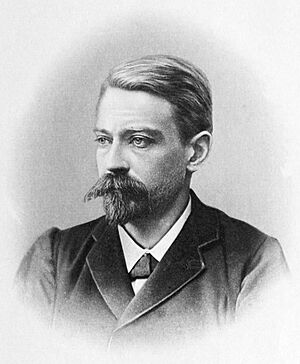Thomas Joannes Stieltjes facts for kids
Quick facts for kids
Thomas Joannes Stieltjes
|
|
|---|---|
 |
|
| Born | 29 December 1856 Zwolle, Netherlands
|
| Died | 31 December 1894 (aged 38) Toulouse, France
|
| Nationality | Dutch |
| Alma mater | École Normale Supérieure |
| Known for | Riemann–Stieltjes integral
Lebesgue–Stieltjes integration Stieltjes constants Stieltjes matrix Stieltjes transformation Stieltjes polynomials Laplace–Stieltjes transform Stieltjes–Wigert polynomials Chebyshev–Markov–Stieltjes inequalities Heine–Stieltjes polynomials Stieltjes moment problem Fourier-Stieltjes algebra Henstock-Kurzweil-Stieltjes integral Mertens conjecture Stieltjes–Osgood theorem |
| Scientific career | |
| Fields | Mathematics |
| Institutions | TU Delft, University of Leiden |
| Doctoral advisor | Charles Hermite Jean Gaston Darboux |
Thomas Joannes Stieltjes (born December 29, 1856 – died December 31, 1894) was a brilliant Dutch mathematician. He was a pioneer in solving "moment problems," which are special math puzzles. He also made big contributions to the study of continued fractions. A math institute at Leiden University was even named after him, and so is the important Riemann–Stieltjes integral.
Contents
Life Story of Thomas Stieltjes
Stieltjes was born in Zwolle, a city in the Netherlands, on December 29, 1856. His father, who had the same name, was a civil engineer. This means he designed and built things like roads and bridges. His father was also a politician, working in the Dutch parliament.
Early School Years
Young Stieltjes went to the Polytechnical School in Delft in 1873. But instead of going to classes, he spent his time reading math books by famous mathematicians like Gauss and Jacobi. Because of this, he failed his exams three times! His father was very worried about his future.
A New Start in Astronomy
Luckily, his father was friends with the director of Leiden University's observatory. This friend helped Stieltjes get a job as an assistant there. This was a big chance for him.
Soon after, Stieltjes started writing letters to Charles Hermite, a famous French mathematician. They first talked about how planets move, but their talks quickly turned to math. Stieltjes began to spend all his free time doing math research.
From Stars to Numbers
On January 1, 1883, Stieltjes asked the observatory director if he could stop his astronomy work. He wanted to focus only on math. The director agreed! In May of that year, he married Elizabeth Intveld, who also encouraged him to follow his passion for mathematics.
In September, Stieltjes got a chance to teach at the University of Delft. He taught subjects like analytical geometry, which uses math to describe shapes. He left his job at the observatory at the end of that year.
Becoming a Professor
In 1884, Stieltjes wanted to become a professor in Groningen. He was first accepted, but then turned down because he didn't have the right diplomas. However, his friends Hermite and Professor David Bierens de Haan helped him. They arranged for Leiden University to give him an honorary doctorate. This special degree meant he could become a professor.
In 1885, he became a member of the Royal Netherlands Academy of Arts and Sciences. This is a very important group for smart people in the Netherlands. The next year, he became a foreign member. In 1889, he was made a professor of advanced math at Toulouse University in France.
Stieltjes passed away in Toulouse, France, on December 31, 1894. He was buried there a few days later.
Stieltjes' Math Discoveries
Stieltjes worked on many different areas of math. He studied continued fractions and number theory, which is about the properties of numbers. People sometimes call him "the father of the analytic theory of continued fractions" because his work was so important in this area.
His ideas were also a first step towards understanding Hilbert spaces. These are complex math ideas used in physics and engineering. He also made important discoveries about discontinuous functions (functions with breaks), divergent series (sums that don't settle on one number), and differential equations. He became famous around the world for the Riemann–Stieltjes integral, a special way to calculate areas under curves.
Awards and Recognition
Stieltjes' amazing work on continued fractions earned him the Ormoy Prize. This was a big award from the Académie des Sciences, a famous science academy in France.
See also
- Annales de la Faculté des Sciences de Toulouse
- Chebyshev–Markov–Stieltjes inequalities
- Heine–Stieltjes polynomials
- Laplace–Stieltjes transform
- Lebesgue–Stieltjes integral
- Montel's theorem
- Riemann–Stieltjes integral
- Stieltjes constants
- Stieltjes matrix
- Stieltjes moment problem
- Stieltjes polynomials
- Stieltjes transformation
- Stieltjes–Wigert polynomials

